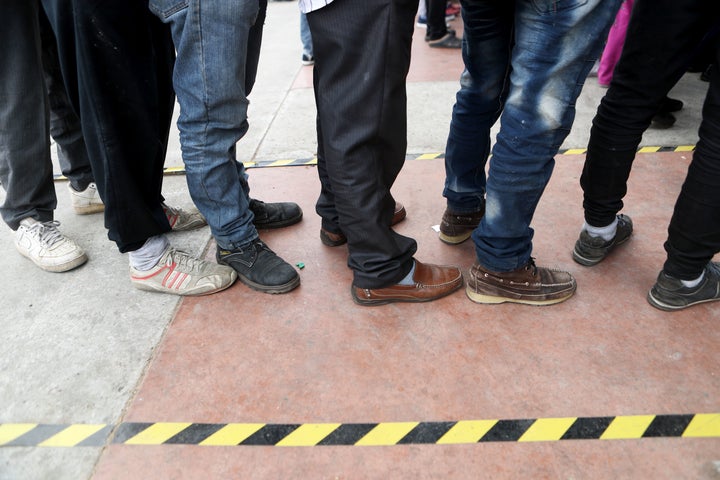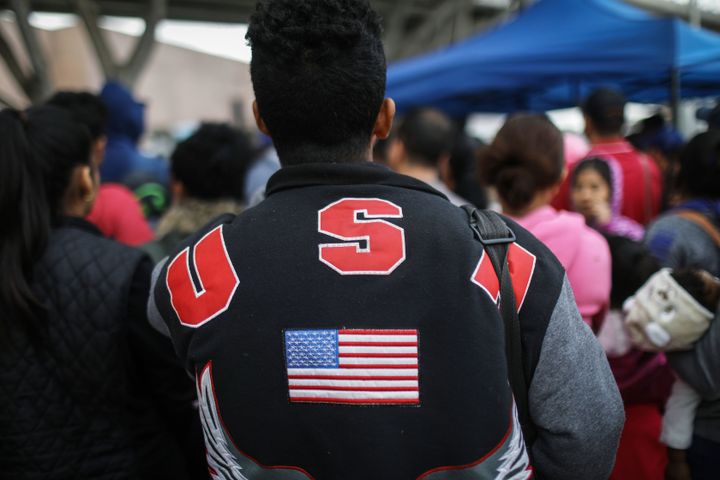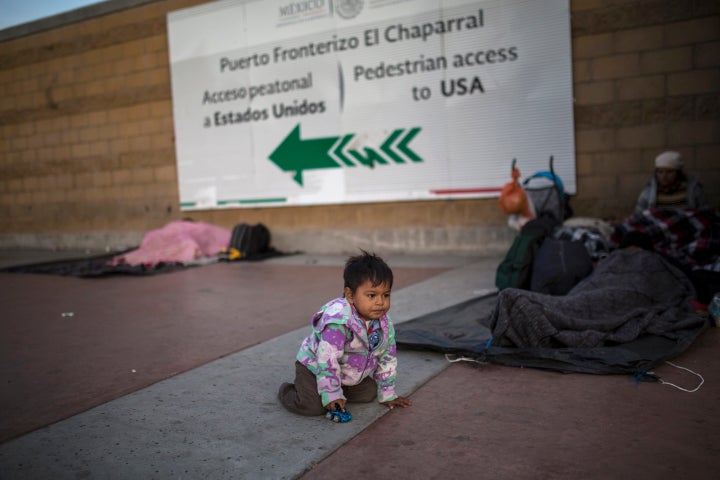
TIJUANA, Mexico ― On a morning last week, shortly after 8 o’clock, two Mexican immigration officers in khaki vests and orange sweatshirts made their way to the blue makeshift tent set up in a corner of El Chaparral plaza in Tijuana.
Eyed by a crowd of nearly 200 expectant and weary migrants, the officers approached one of the volunteers sitting behind the plastic fold-out table in the tent and gave him the number: 70 people. That’s how many asylum-seekers U.S. Customs and Border Patrol would be letting through that day.
The volunteer, a Nicaraguan migrant named Pedro, stood in front of the crowd and started reading names and numbers off a hard-cover ledger: “1,219... 1,220... 1,221...” The migrants whose numbers were called stepped forward and presented their ID cards. A few hours later, they’d be put on a minibus and taken to the nearby San Ysidro Port of Entry to talk to CBP officials. (Pedro and the other migrants in this story are identified by pseudonyms, as revealing their names could risk their safety and endanger their asylum process.)
Pedro’s hard-cover ledger contains the asylum waiting list known colloquially as “La Lista.” It’s an ad hoc system drawn up and managed by migrant volunteers that has gained new urgency in response to the Trump administration’s limitations on the number of asylum-seekers allowed into the U.S.
The list determines the futures of thousands of asylum-seekers who have gathered in this border town, but it is run neither by American nor Mexican immigration officials. Instead, the U.S. and Mexican governments have left the job of managing access to the ports of entry to asylum-seekers themselves. The governments’ failure to fulfill a fundamental state function has led to a process that leaves migrants with a lot of uncertainty and little legal protection.
“What we are seeing is two states [Mexico and the U.S.] that are completely abdicating their responsibilities in order to protect themselves from any liability in this process,” David Baluarte, a law professor at Washington and Lee University, told HuffPost. The process is meant to restrict the number of asylum-seekers who directly approach the border to request asylum, even though that’s an international right, Baluarte explained. “It is completely illegal,” he added.

The scene has played out repeatedly every day for the past few months. Dozens of migrants line up in front of the blue tent in El Chaparral while hundreds of others sit around waiting to hear the day’s numbers. One by one, the migrants approach the plastic table, list their country of origin and show their birth certificates and ID cards. A volunteer manning the desk writes it all down ― 10 names per number. Another volunteer scribbles the number on a piece of scratch paper and hands it to the asylum-seeker.
As of Wednesday, more than 5,000 asylum-seekers were waiting in Tijuana for an interview. At San Ysidro, border agents have typically processed 30 to 100 people a day, the volunteers told HuffPost. The wait time averages more than two months.
The Trump administration says this strategy, which it calls “metering,” is meant to reduce logistical constraints on CBP. “Port of Entry facilities were not designed to hold hundreds of people at a time who may be seeking asylum,” a CBP spokesperson told HuffPost. “Depending upon circumstances at the time of arrival, individuals may need to wait in Mexico.”
But the delays go hand-in-hand with the administration’s recent attempt to ban the right to asylum for those who enter the U.S. illegally, which has since been overturned by a federal judge. Taken together, these two policies show a clear, concerted effort to deter migrants who are fleeing persecution in their home countries from seeking protection in the U.S.
The ad hoc process in Tijuana has led to confusion and insecurity among asylum-seekers. While the list has brought some order, the process is far from perfect.
Migrants have no legal guarantee their number will ever be called. Though the volunteers try to estimate when their name will come up, they never know exactly when it will be their turn. Fearful they will lose their opportunity to enter the U.S. if they aren’t present when their number is called, most of the migrants on the list travel to El Chaparral plaza every few weeks to check the status of the ledger ― even though wait times are currently far longer, according to the volunteers in charge.
One migrant managing the list told HuffPost that those absent when their number is called are “moved to the end of the line.” But some migrants have suggested it’s possible to regain your spot by paying a bribe or to pay to get names written in the ledger even before arriving in Tijuana. While the list’s managers acknowledge that some have attempted to pay bribes, they deny that they have ever accepted such payments.

As the wait continues, some members of the migrant caravan have launched a hunger strike to pressure the U.S. to allow them to apply for asylum.
More than 6,000 Central American migrants, mostly from Honduras, arrived in Tijuana with the caravan in mid-November, after traveling more than 2,500 miles to reach the border. Their numbers on the list start around 1,400, making it likely they’ll wait a total of at least six weeks before being able to cross the border.
“We are doing this for the women and children who have to wait for months in these poor conditions,” said Joaquin, one of the 17 migrants participating in the hunger strike. “We didn’t come to Tijuana to cross illegally but to legally ask for asylum. And we are demanding the right to do so.”
